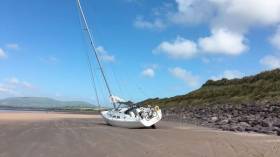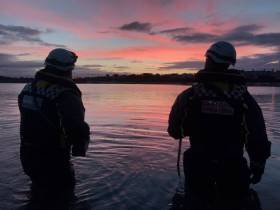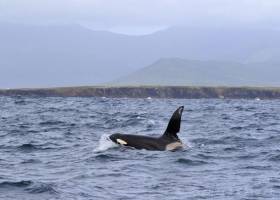Displaying items by tag: Kerry
Tragedy As Three Fishermen Found Dead In Kerry Harbour
The death of three men whose upturned fishing boat was found off Coonanna in Co Kerry last night has “devastated” the local community, as BreakingNews.ie reports.
Post-mortems will be carried out today (Monday 1 October) on the bodies of the three Eastern European fishermen, who lived in the area.
It is understood that two of the men were found underneath their upturned 15ft fishing punt in the sheltered end of Coonanna harbour. The third may have tried to reach the shore before he died.
BrekaingNews.ie has more on the story HERE.
Irish Offshore Rowing Championships Set for Kerry
#Rowing: Portmagee Rowing club will host the Irish Offshore Rowing Championships on Saturday, September 8th. The event will be run by Rowing Ireland and the venue is O’Carroll’s Cove beach bar near Caherdaniel in County Kerry. This will be the first time this event will be held in Kerry.
More than 80 crews, made up of 220-plus oarsmen and women will compete for national titles. The event is the Fisa ranking event for the World Coastal Rowing Championships 2018 which will be held in Canada in October.
Kerry rowers have a good record in Coastal/Offshore Rowing. Ireland international Monika Dukarska, from the Killorglin Rowing Club, is a double world champion in the women’s single. Johnny Casey, whose grandfather was one of the legendary Caseys of Sneem, was the Irish men’s single champion last year.
This year’s course for the Offshore Championships is the same stretch of water that the Caseys, the "toughest family on earth", would have trained and raced on in the Seine boat during their heyday in the 1920s and 1930s. Johnny also teamed up with his brother James and uncle and father, Steve and Patrick, to win the All Ireland senior men’s four 20 years ago.
This year, the Courtmacsherry men’s quad crew who have defeated all comers over the last few years, put their title on the line. Waiting to take them on are the might of Muckross. Paul Griffin, an Ireland Olympian in Athens in 2004, when his Ireland lightweight four reached the A Final, and Beijing in 2008, is set to be in their ranks.
Flesk Valley and Workmen's Senior Champions at All Ireland Rowing
#CoastalRowing: The good results kept coming for Kerry clubs on the second day of the All Ireland Coastal Rowing Championships in Wexford. Flesk Valley won the senior men’s championship, while Workmen’s took the senior women’s crown. A Donegal club did break into the winning ranks. Cumann Rámhaíochta Chloich Cheann Fhaola (Cloughaneely CCF) had wins in women’s, men’s and mixed classes.
ICRF All Ireland Coastal Championships (Selected Results; winners):
Saturday
Men
Open Classic: Cloughaneely CCF
Celtic Longboats: Vartry A
Heritage: St Patrick’s. Under-18: Cromane
East Coast Skiffs: St Patrick’s. Under-16: Stella Maris
Under-21: Flesk Valley
Under-16: Fossa
Intermediate: Workmen’s.
Pre Veterans: Commercial, Killarney
Masters: Glenarm
Women
Celtic Longboats: Vartry
Heritage: St Patrick’s A. Under-18 Heritage: Cromane
Open Classic: Cloughaneely CCF
East Coast Skiffs: St Michael’s. Novice: Fingal
Under-21: Workmen’s
Intermediate: Workmen’s
Pre Veterans: Workmen’s
Mixed
Veteran: Workmen’s A
Sunday
Men
Senior: Flesk Valley
Currach: Cloughaneely CCF
Novice: Flesk Valley
Junior: Vartry
Under 18: Workmen’s
Veteran: Commercial, Killarney
Women
Senior: Workmen’s
Currach: Fergus
Novice: Cloughaneely CCF
Junior: Workmen’s
Under 18: Workmen’s
Under 16: Flesk Valley
Veteran: Sneem
Mixed
Senior: Vartry
Currach: Cloughaneely CCF
Pre-Vet: Workmen’s
Masters: Templenoe
Kayaker Drowns In Incident Off Kerry Coast
#Kerry - RTÉ News reports that a kayaker drowned off the Iveagh Peninsula in Co Kerry yesterday afternoon, Friday 10 August.
Emergency services were alerted around 2.30pm to Cromane after the kayaker had been recovered from the water by a local fisherman who attempted CPR, but the casualty was pronounced dead at the scene.
Storm Hector Blows Yacht Ashore On Kerry Coast
#StormHector - One sorry yacht owner felt the wrath of Storm Hector today (Thursday 14 June) when their vessel was founded beached near Waterville in Co Kerry, as RTÉ News reports.
The Hanse yacht, named Seabiscuit, broke its mooring in Ballinskelligs Bay and was blown ashore on Inny Strand below Waterville Golf Course amid severe gusts that were forecast to reach as high as 125kmh overnight.
A Status Yellow small craft warning remains in effect on coasts from Hook Head to Erris Head to Howth Head with west to southwest winds reaching Force 6 or higher.
Fishermen Rescued After Vessel Sinks Off Kerry Coast
#Rescue - RTÉ News reports that two fishermen were rescued after abandoning their sinking vessel off the Kerry coast this afternoon, Monday 7 May.
The Shannon-based Irish Coast Guard helicopter Rescue 115 was dispatched to the scene south off Scariff Island to recover the two men from their life raft.
Night Rescue Of Kerry Surfer From Foggy Cliffs
#Rescue - A surfer was rescued in West Kerry on Monday night (22 May) after he was pulled from the shore by a rip current, as RTÉ News reports.
Dingle Coast Guard and Valentia RNLI fought difficult conditions – with a heavy swell and thick fog – to locate the man, who had managed to climb onto rocks beneath high cliffs near Com Dhíneol, a popular surfing spot.
The incident occurred just weeks after a Scottish surfer was rescued off Northern Ireland after more than 30 hours at sea.
Elsewhere, gardaí are continuing to investigate after a person was reportedly spotted in difficulty in the water near Sutton Dinghy Club on Monday night.
Howth Coast Guard and RNLI lifeboat crews from Howth and Dun Laoghaire found nothing on their low water searches, concentrating on the area between Sutton and Dollymount Strand and returning twice more, before dawn on Tuesday (23 May) and later that afternoon.
Kerry Dolphin Deaths As Supertrawlers Ply Nearby Seas
#MarineWildlife - Three dead dolphins have washed up on Kerry's shores in recent days – and one Irish fishery expert believes so-called 'supertrawlers' in the area might be responsible.
According to The Irish Times, former Sea Fisheries Protection Authority inspector Kevin Flannery says one of the three common dolphins found between Dingle and Smerwick Harbour since last weekend had a rope around its tail, presumably discarded from a fishing vessel.
He added that while there is no proof of precisely what became of the dolphins, it was "no coincidence" that the incidents occurred while a fleet of mainly Dutch factory fishing ships was spotted off the Blasket Islands.
The Irish Times has more on the story HERE.
Kerry Treated To Rare Sighting Of Killer Whale 'John Coe'
#MarineWildlife - Whale watchers on Slea Head were treated to a special sight earlier this week with the surprise appearance of the killer whale known as John Coe, as the Irish Examiner reports.
Landscape photographer Richard Creagh was among the lucky few on Monday (27 June) to spot the orca known by the distinctive notch on his dorsal fin – though in more recent times he's also lost a chunk of his tail fluke, most likely to a shark bite.
Creagh, a keen marine wildlife watcher for the last 10 years, said: "Up to now killer whales had always eluded me but today I got to add them to my list, and what a sight it was! I’m still buzzing!"
John Coe's unique orca pod are regular visitors to Irish waters, though he himself was last spotted close to our shores almost three years ago at the Inishkeas in Co Mayo, according to the Irish Whale and Dolphin Group – which is asking the public to watch the seas for any more sightings of the senior cetacean.
Following our earlier photo from Baltimore Sea Safari of a Humpback Whale breaching in spectacular fashion off the West Cork coast, Kerry reader Brian O'Sullivan (of marine firm O'Sullivan's Marine) has sent Afloat.ie this latest image of further breaching off Fenit yesterday.




































































